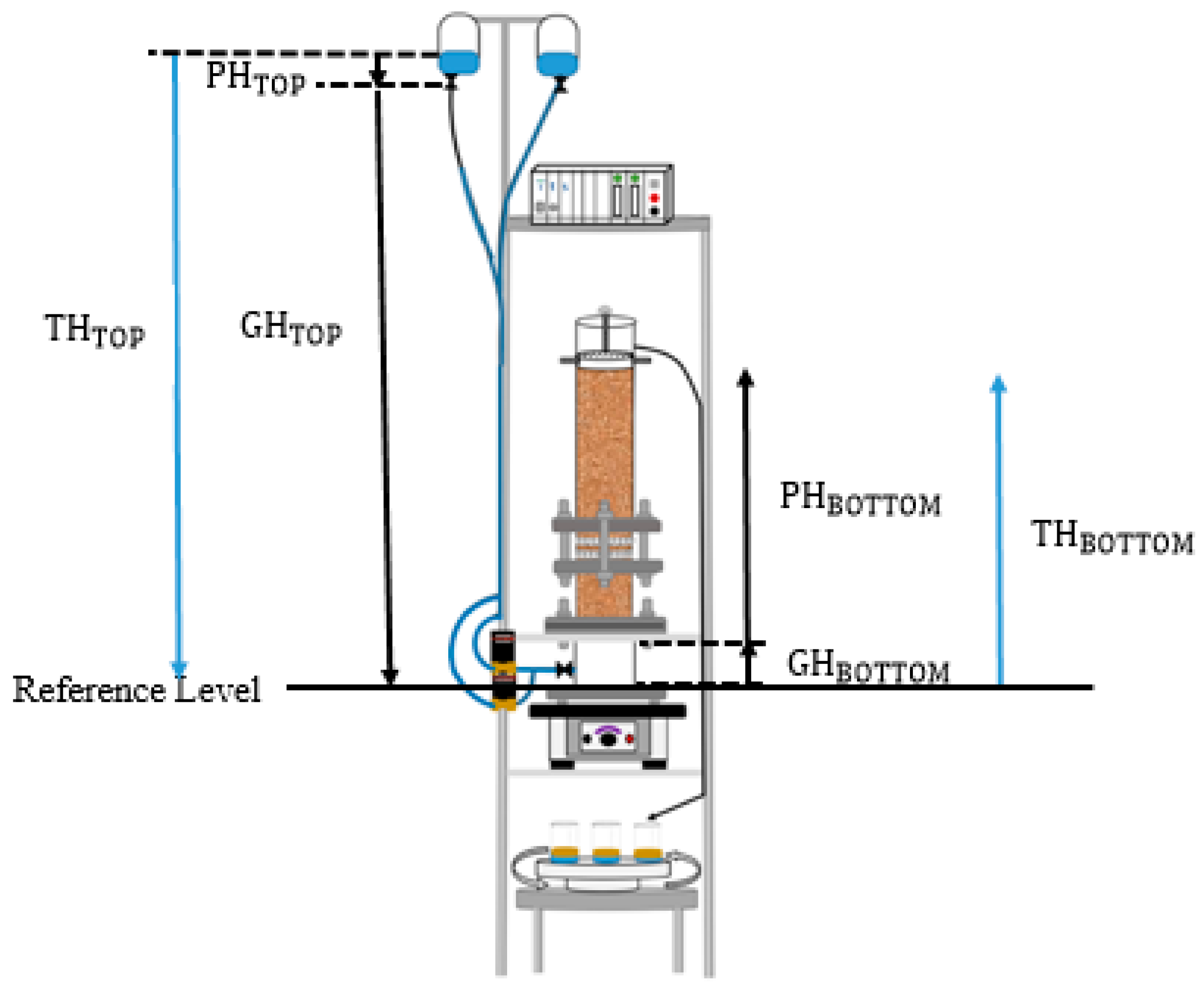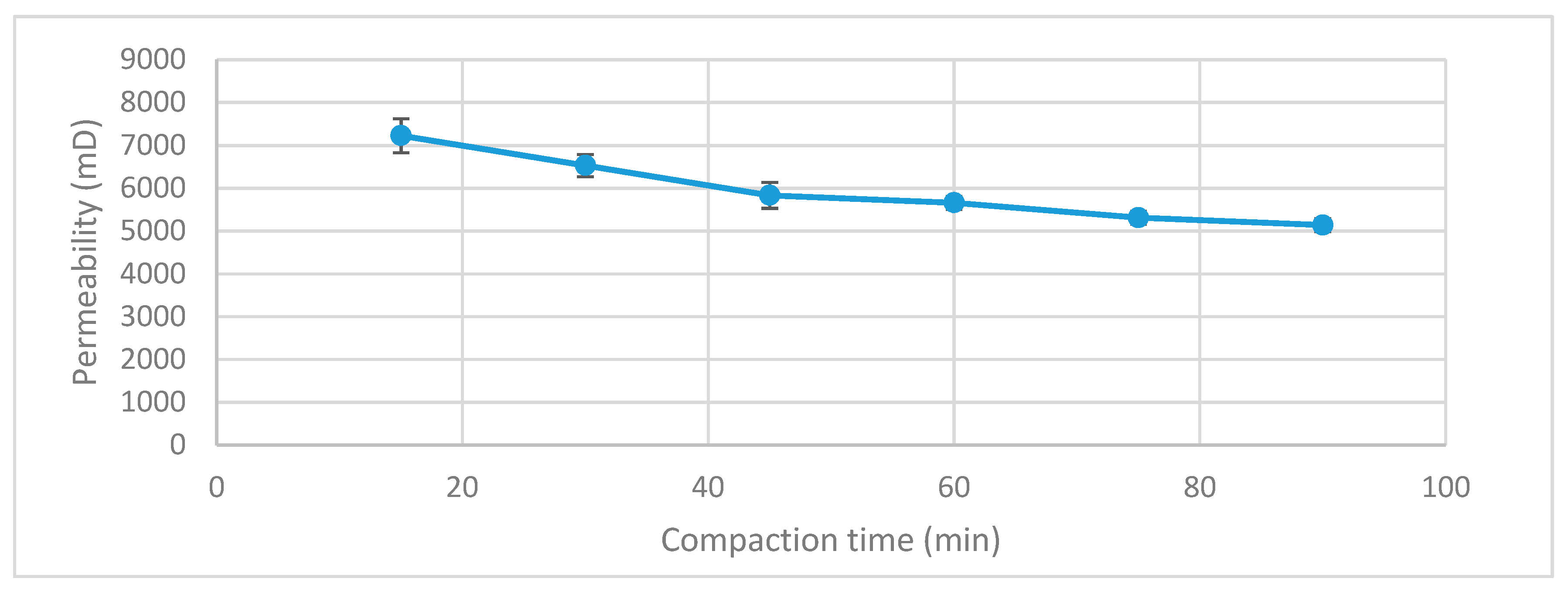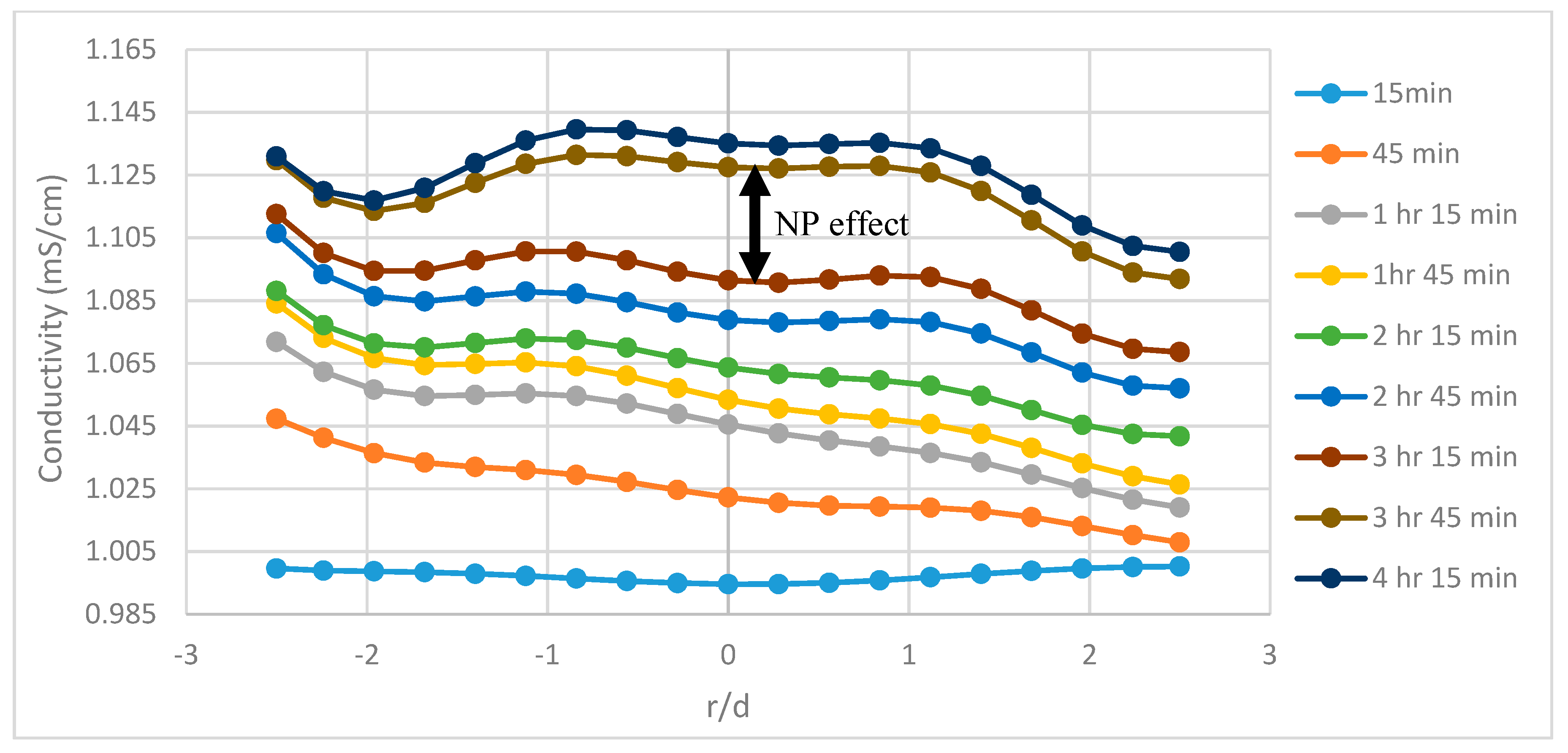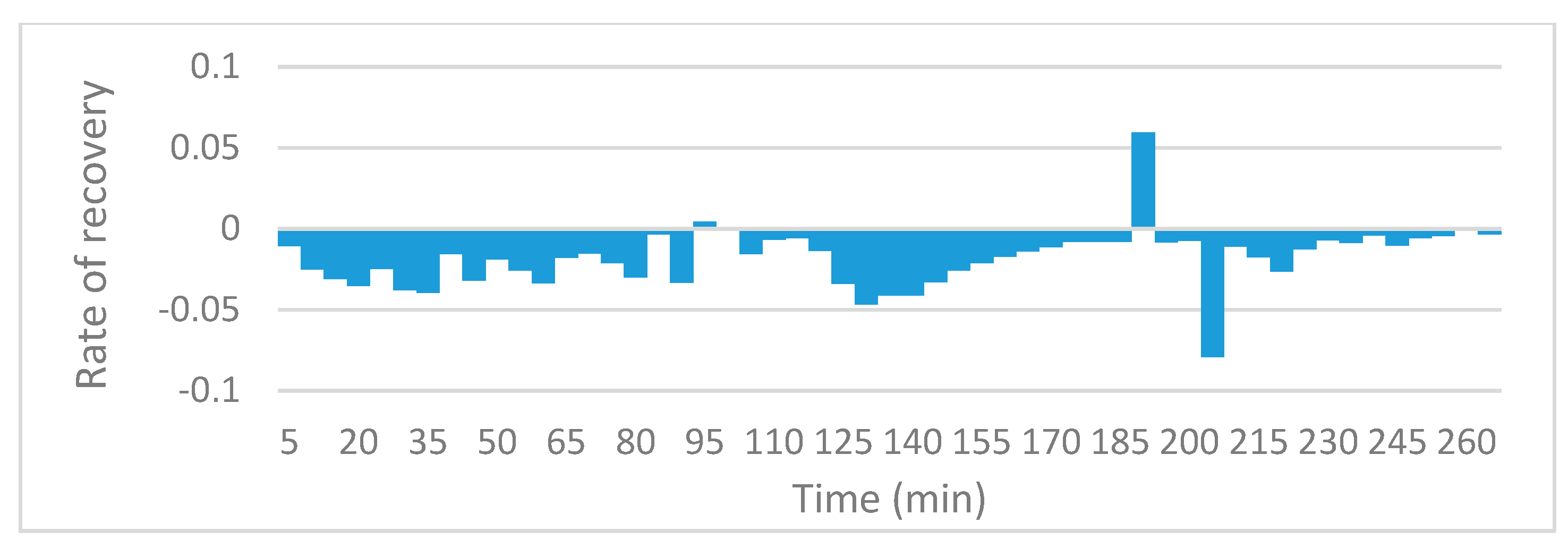Nanoparticle Assisted EOR during Sand-Pack Flooding: Electrical Tomography to Assess Flow Dynamics and Oil Recovery †
Abstract
:1. Introduction
2. Materials and Methods
2.1. The System
2.2. Gravity Feed System
2.3. Vibrating Oscillator
2.4. Effluent Collection System
2.5. Sand-Pack Flooding Preparations
2.6. Sand-Pack Flooding Procedure
2.7. Materials
3. Results and Discussion
3.1. Flow Imaging
3.2. Resistivity vs. Time
3.3. Oil Recovery Rate
3.4. Cumulative Oil Recovery
3.5. Recovery Mechanisms
4. Conclusions
Author Contributions
Funding
Acknowledgments
Conflicts of Interest
References
- Binley, A.; Shaw, B.; Henry-Poulter, S. Flow Pathways in Porous Media: Electrical Resistance Tomography and Dye Staining Image Verification. Meas. Sci. Technol. 1996, 7, 384–390. [Google Scholar] [CrossRef]
- Gnecchi, J.G.; Chávez, A.G.T.; Campos, G.C.; Peregrino, V.O.; Pineda, E.M. Soil Water Infiltration Measurements Using Electrical Impedance Tomography. Chem. Eng. J. 2012, 191, 13–21. [Google Scholar] [CrossRef]
- Kaipo, P. Measuring Water Flow in Soil Using Electrical Impedance Tomography. Ph.D. Thesis, Savonia University of Applied Sciences, Kuopio, Finland, 2014. [Google Scholar]
- Singh, S.; Ahmed, R.M.; Growcock, F. Vital role of nanopolymers in drilling and stimulations fluid applications. In Proceedings of the SPE 130413, SPE Annual Technical Conference and Exhibition, Florence, Italy, 19–22 September 2010. [Google Scholar]
- Ogolo, N.; Olafuyi, O.; Onyekonwu, M. Enhanced Oil Recovery Using Nanoparticles. In Proceedings of the SPE Saudi Arabia Section Technical Symposium and Exhibition, AI-Khobar, Saudi Arabia, 8–11 April 2016. [Google Scholar]
- Rodriguez, E.; Roberts, M.R.; Yu, H.; Huh, C.; Bryant, S.L. Enhanced Migration of Surface-Treated Nanoparticles in Sedimentary Rocks. In Proceedings of the SPE 124418 Annual Technical Conference and Exhibition, New Orleans, LA, USA, 4–7 October 2009. [Google Scholar]
- Hendraningrat, L.; Zhang, J. Polymeric Nanospheres as a Displacement Fluid in Enhanced Oil Recovery. Appl. Nanosci. 2015, 5, 1009–1016. [Google Scholar] [CrossRef]
- Elsayed, R.; Fattah, A. A Comparative Study between Nanoparticles Method and the Other Methods for Increasing Heavy Oil Recovery. Master’s Thesis, Suez University, Suez, Egypt, 2014. [Google Scholar]
- Ju, B.; Fan, T.; Li, Z. Improving Water Injectivity and Enhancing Oil Recovery by Wettability Control Using Nanopowders. J. Pet. Sci. Eng. 2012, 86, 206–216. [Google Scholar] [CrossRef]
- El-Diasty, A.I. The Potential of Nanoparticles to Improve Oil Recovery in Bahariya Formation, Egypt: An Experimental Study. In Proceedings of the SPE 174599 Annual Technical Conference and Exhibition, Cairo, Egypt, 11–13 August 2015. [Google Scholar]
- Wang, M.; Yin, W.; Holliday, N. A highly adaptive electrical impedance sensing system for flow measurement. Meas. Sci. Technol. 2002, 13, 1884–1889. [Google Scholar] [CrossRef]
- Baldygin, A.; Nobes, D.S.; Mitra, S.K. New laboratory core flooding experimental system. Ind. Eng. Chem. Res. 2014, 53, 13497–13505. [Google Scholar] [CrossRef]
















| Effluent Collection Table Parameters | |||||||
|---|---|---|---|---|---|---|---|
| Product Model | Diameter (mm) | Height (mm) | Transmission Gear Material | Control Method | Speed Range (Sec/Rev) | Net Weight (Kg) | Handling Load (Kg) |
| MT370L20 | 370.8 | 8 | POM + Metal | Infrared + Bluetooth | 15–31.5 | 5.5 | 20 |
| Fluid Type | Volume (mL) | Pre-Mixing Conductivity (mS/cm) | Mixing Brine Volume and Conductivity | Post Mixing Conductivity (mS/cm) | |
|---|---|---|---|---|---|
| Tracer | Probe | ||||
| DI Water | 2000 | 0.033 | 100 mL @ 0.6 mS/cm | 0.061 | 0.059 |
| 0.5 wt% SiO2 | 1000 | 0.041 | 100 mL @ 0.025 mS/cm | 0.060 | 0.058 |
| 1.0 wt% SiO2 | 1000 | 0.044 | 100 mL @ 0.22 mS/cm | 0.060 | 0.061 |
| Sand-Pack Parameters | |
|---|---|
| Pressure in (psi) | 19.9 |
| Pressure out (psi) | 14.9 |
| Distance (cm) | 40 |
| Area (cm2) | 667.59 |
| Discharge (mL/min) | 2 |
| Viscosity (Pa·s) | 0.89 |
| Permeability (mD) | 5225 |
| Fluid Type | Initial Oil Saturation, % PV | Run | Oil Recovery, % OIIP | Residual Oil Saturation, % PV | Total Recovery, % OIIP | ||
|---|---|---|---|---|---|---|---|
| WF1 | NF Pulsations | WF1 | NF Pulsations | ||||
| Brine | 66 | 1 | 42.6 | - | 37.8 | - | 42.6 |
| 2 | 40.9 | - | 39.0 | - | 40.9 | ||
| 3 | 42.0 | - | 38.3 | - | 42.0 | ||
| Mean | 41.8 | - | 38.4 | - | 41.8 | ||
| 0.5 wt% SiO2 | 66 | 1 | 41.0 | 2.8 | 38.9 | 37.0 | 43.8 |
| 2 | 42.0 | 2.0 | 38.3 | 36.9 | 44.0 | ||
| 3 | 42.8 | 2.3 | 37.8 | 36.2 | 45.1 | ||
| Mean | 41.9 | 2.4 | 38.3 | 36.7 | 44.3 | ||
| 1.0 wt% SiO2 | 66 | 1 | 40.7 | 4.1 | 39.1 | 36.4 | 44.8 |
| 2 | 40.8 | 3.8 | 39.1 | 36.5 | 43.0 | ||
| 3 | 41.2 | 5.2 | 38.9 | 35.4 | 45.4 | ||
| Mean | 41.4 | 4.3 | 39.0 | 36.1 | 44.7 | ||
© 2019 by the authors. Licensee MDPI, Basel, Switzerland. This article is an open access article distributed under the terms and conditions of the Creative Commons Attribution (CC BY) license (http://creativecommons.org/licenses/by/4.0/).
Share and Cite
Nwufoh, P.; Hu, Z.; Wen, D.; Wang, M. Nanoparticle Assisted EOR during Sand-Pack Flooding: Electrical Tomography to Assess Flow Dynamics and Oil Recovery. Sensors 2019, 19, 3036. https://doi.org/10.3390/s19143036
Nwufoh P, Hu Z, Wen D, Wang M. Nanoparticle Assisted EOR during Sand-Pack Flooding: Electrical Tomography to Assess Flow Dynamics and Oil Recovery. Sensors. 2019; 19(14):3036. https://doi.org/10.3390/s19143036
Chicago/Turabian StyleNwufoh, Phillip, Zhongliang Hu, Dongsheng Wen, and Mi Wang. 2019. "Nanoparticle Assisted EOR during Sand-Pack Flooding: Electrical Tomography to Assess Flow Dynamics and Oil Recovery" Sensors 19, no. 14: 3036. https://doi.org/10.3390/s19143036




